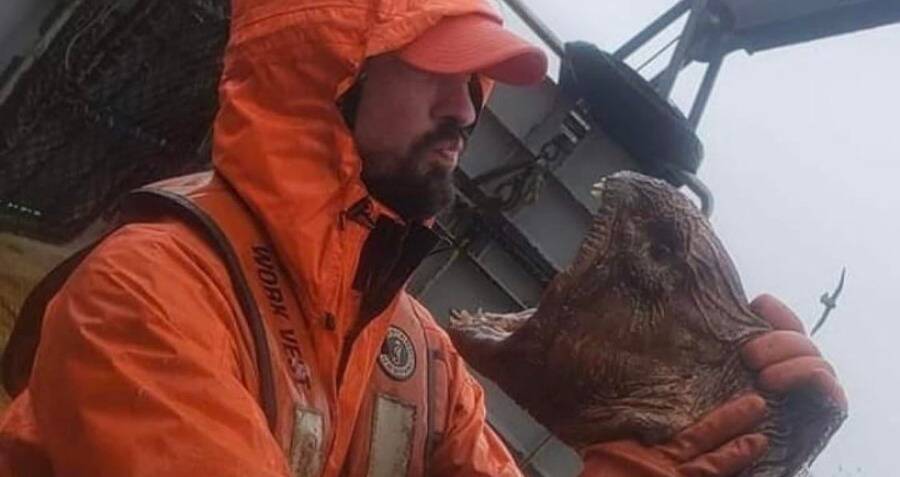

In that moment, I knew it really wasn’t good. Up shot an eel, swimming toward me at a million miles an hour, biting the water column all around me. As soon as I opened the bucket, a thick cloud of blood gushed out. I thought I’d give it a piece of fish while I waited. When I reached 55 feet, a barracuda nosed in, making a pass around me.

I jumped in, telling everyone to meet me at the bottom at 65 feet. I didn’t think about how fresh catch deviated from our procedure - typically, I’d chop fish into bite-size pieces, then freeze it all.Ĭonditions were calm that day. I swung by before work, stocking the five-gallon bucket we used for daily fish feeds offered through Dive Experience, the St. A local fisherman rang to say he had fresh tuna. This is where divers have the best chance of encountering wolf eels and giant Pacific octopus.The morning the call came in, I thought nothing of it. Running between the international boundary of Canada and the United States, the Strait of Juan de Fuca is notorious for orca sightings and a plethora of the most-unique marine species that inhabit the Pacific Northwest. When the salmon run in local rivers, migrating Steller sea lions may also visit divers in the shallows. Divers who visit during the winter may encounter squid congregating in the thousands to spawn. With average year-round temperatures of 45 F (7 C), drysuits are a must. Harbor seals and orcas stray close to the beach during the summer, so keep an eye on the stretch of water between Elliot Bay and Puget Sound.ĭuring winter the visibility can reach up to 100 feet (30 m), but during the summer months 10 to 50 feet (3 to 15 m) is more realistic. Fortunately, conservationists have found their global population to be stable for now. The species is often caught in fish traps and crab nets, and are threatened by pollutants in the ocean. Gray whales graze here in the spring and throughout the year divers can see plumose anemone, northern kelp crab and rockfish. However, the wolf eel faces its gravest danger from mankind. With depths of up to 60 feet (18 m), Alki Beach Park has plenty of man-made reef structures embedded in the mud beds. Visitors flock to this natural waterway every year to collect oysters and crabs, but other creatures, such as Giant Pacific octopus, wolf eels and anemones, are common as well.Ī bed of strawberry anemones surrounds a lingcod Hood CanalĪn ancient fjord and part of the Salish Sea, Hood Canal skirts the edge of famed Olympic National Park, an ideal spot for a hike through lush forests and over burbling streams. Water temperatures fluctuate during the year but average from 45 to 55 F (7 to 12 C). The dive season is best between late spring and early fall when the water is warmer, and lucky divers may experience visibility up to 100 feet (28 m). Be warned that strong tides and rip currents can create potentially dangerous conditions. Divers sometimes spot larger species, including sea lions and orcas when they near shallower landmasses to feed on prey that hides in the kelp.

You’ll likely see invertebrates including king and Dungeness crab and, most impressively, lingcod. Under the Deception Pass Bridge, steep walls are laden with giant plumose and other colorful anemones. Orcas, San Juan, Lopez and Shaw Islands are accessible by car and therefore the easiest to dive from, however, a plethora of other islands are easily accessible by boat. Underwater, the dramatic, rocky walls and reefs hold the islands’ greatest treasures - their marine life. The rocky coastline features luscious green hills where farms produce cheese and wine. Stunningly beautiful, the islands are a popular outdoor recreation spot for kayaking with orcas. Situated on the northern border of Western Washington between Vancouver, Canada and Seattle, this archipelago features over 400 islands.

Here are out picks for the top sites in Washington State. Deep drop-offs in the Puget Sound and wild drift dives throughout the many islands of the Strait of Juan de Fuca will enthrall both beginner and advanced divers with sightings of giant octopus, wolf eels, Steller sea lions and for a lucky few, orcas. Many dive shops now offer unique boat and shore dives throughout the year where encounters with even more eclectic creatures are possible. But if you have the correct equipment, particularly a drysuit, Washington State offers many jewels of cold-water diving. Frigid, emerald waters are the quintessence of Pacific Northwest diving.


 0 kommentar(er)
0 kommentar(er)
